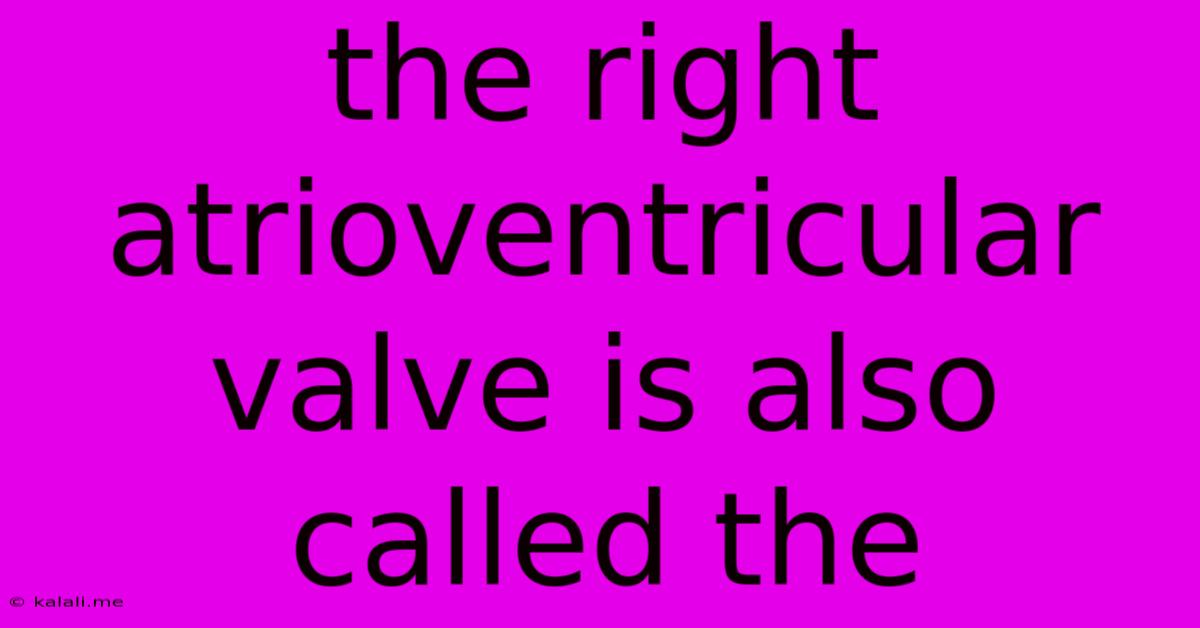The Right Atrioventricular Valve Is Also Called The
Kalali
May 08, 2025 · 3 min read

Table of Contents
The Right Atrioventricular Valve: Also Known as the Tricuspid Valve
The heart, a remarkable organ, is responsible for tirelessly pumping blood throughout our bodies. Its intricate structure relies on a series of valves to ensure unidirectional blood flow. One such crucial valve is the right atrioventricular valve, also known as the tricuspid valve. This article delves into the anatomy, function, and clinical significance of this essential component of the cardiovascular system.
Understanding the Right Atrioventricular Valve
The right atrioventricular valve is located between the right atrium and the right ventricle of the heart. Its primary function is to prevent the backflow of blood from the right ventricle back into the right atrium during ventricular contraction (systole). This precise control of blood flow is critical for maintaining efficient circulation. Understanding its alternative name, the tricuspid valve, provides further insight into its structure.
Why "Tricuspid"? The Anatomy of the Valve
The term "tricuspid" directly relates to the valve's anatomy. Unlike the mitral valve (bicuspid valve) on the left side of the heart, which has two leaflets (or cusps), the tricuspid valve possesses three distinct leaflets. These leaflets are composed of fibrous connective tissue covered by endocardium, the inner lining of the heart. These three cusps – anterior, septal, and posterior – are anchored to the ventricular wall by chordae tendineae, strong fibrous cords connected to papillary muscles. These structures work in concert to ensure the valve's proper closure during ventricular contraction.
The Role of the Tricuspid Valve in the Cardiac Cycle
During diastole (ventricular relaxation), the tricuspid valve opens, allowing deoxygenated blood to flow passively from the right atrium into the right ventricle. As the right ventricle begins to contract, the pressure within the ventricle increases, forcing the tricuspid valve to close. This closure prevents the backflow of blood into the right atrium, ensuring that blood is efficiently pumped into the pulmonary artery and subsequently to the lungs for oxygenation. The coordinated action of the tricuspid valve, chordae tendineae, and papillary muscles is crucial for the maintenance of this unidirectional flow.
Clinical Significance: Tricuspid Valve Disorders
Dysfunction of the tricuspid valve can lead to several serious conditions. Tricuspid regurgitation, a condition where the valve doesn't close properly, allows blood to leak back into the right atrium during ventricular contraction. This can lead to reduced cardiac output and symptoms like fatigue, shortness of breath, and edema (swelling). Tricuspid stenosis, a narrowing of the valve opening, restricts blood flow from the right atrium to the right ventricle. This can lead to similar symptoms as regurgitation, as well as an increase in pressure in the right atrium. These conditions can be diagnosed through various methods, including echocardiography and cardiac catheterization. Treatment options vary depending on the severity of the condition and may include medication, surgical intervention, or transcatheter procedures.
In Conclusion:
The right atrioventricular valve, also known as the tricuspid valve, plays a vital role in maintaining the efficient flow of blood through the heart. Its unique three-leaflet structure, along with its supporting structures, ensures that blood flows unidirectionally from the right atrium to the right ventricle. Understanding the anatomy and function of this valve, as well as the potential for associated pathologies, is crucial for healthcare professionals and individuals alike. Further research continues to unravel the complexities of the tricuspid valve and its role in overall cardiovascular health.
Latest Posts
Latest Posts
-
How Many Heart Chambers Does An Amphibian Have
May 08, 2025
-
What Is 3 7 As A Percentage
May 08, 2025
-
What Is The Function Of The Diaphragm Of A Microscope
May 08, 2025
-
Whats The Square Root Of 65
May 08, 2025
-
What Percentage Is 5 Out Of 17
May 08, 2025
Related Post
Thank you for visiting our website which covers about The Right Atrioventricular Valve Is Also Called The . We hope the information provided has been useful to you. Feel free to contact us if you have any questions or need further assistance. See you next time and don't miss to bookmark.